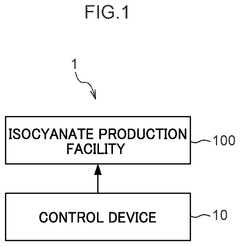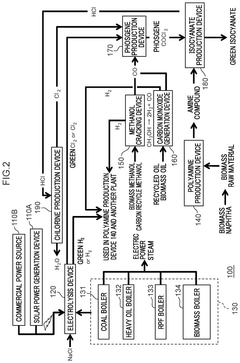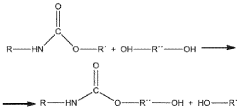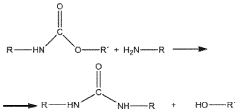Isocyanate Processing Techniques for Reduced Environmental Impact
JUL 10, 20259 MIN READ
Generate Your Research Report Instantly with AI Agent
Patsnap Eureka helps you evaluate technical feasibility & market potential.
Isocyanate Tech Evolution
Isocyanate processing techniques have undergone significant evolution since their inception in the mid-20th century. Initially, the focus was primarily on improving production efficiency and product quality, with little consideration for environmental impact. However, as awareness of environmental issues grew, the industry began to shift towards more sustainable practices.
In the 1970s and 1980s, the first major environmental concerns related to isocyanate processing emerged, particularly regarding the release of volatile organic compounds (VOCs) and the use of ozone-depleting substances as blowing agents. This led to the development of alternative blowing agents and improved emission control systems.
The 1990s saw a surge in research and development aimed at reducing the environmental footprint of isocyanate processing. Key advancements included the introduction of water-blown foam systems, which eliminated the need for harmful chlorofluorocarbons (CFCs) and hydrochlorofluorocarbons (HCFCs). Additionally, the implementation of closed-loop systems and solvent recovery technologies helped minimize waste and emissions.
As the new millennium began, the focus shifted towards optimizing raw material usage and energy efficiency. Manufacturers began adopting more precise mixing and dispensing technologies, resulting in improved product consistency and reduced material waste. Concurrently, the development of low-temperature curing systems and catalysts allowed for significant energy savings in the production process.
In recent years, the industry has made substantial progress in developing bio-based and renewable isocyanates. These innovations aim to reduce reliance on petroleum-derived raw materials and decrease the overall carbon footprint of isocyanate products. Researchers have successfully synthesized isocyanates from plant-based sources, such as vegetable oils and cellulose, opening new avenues for sustainable production.
Another significant trend in isocyanate processing evolution is the adoption of advanced automation and digital technologies. Industry 4.0 concepts, including real-time process monitoring, predictive maintenance, and artificial intelligence-driven optimization, have been increasingly integrated into production lines. These technologies not only enhance efficiency but also contribute to reduced environmental impact by minimizing errors, waste, and energy consumption.
The most recent developments in isocyanate processing techniques focus on circular economy principles. Manufacturers are exploring ways to recycle and upcycle isocyanate-based products, particularly in the polyurethane foam sector. Novel chemical recycling methods and mechanical recycling processes are being developed to break down end-of-life products and recover valuable raw materials, thus reducing the need for virgin resources and minimizing waste.
In the 1970s and 1980s, the first major environmental concerns related to isocyanate processing emerged, particularly regarding the release of volatile organic compounds (VOCs) and the use of ozone-depleting substances as blowing agents. This led to the development of alternative blowing agents and improved emission control systems.
The 1990s saw a surge in research and development aimed at reducing the environmental footprint of isocyanate processing. Key advancements included the introduction of water-blown foam systems, which eliminated the need for harmful chlorofluorocarbons (CFCs) and hydrochlorofluorocarbons (HCFCs). Additionally, the implementation of closed-loop systems and solvent recovery technologies helped minimize waste and emissions.
As the new millennium began, the focus shifted towards optimizing raw material usage and energy efficiency. Manufacturers began adopting more precise mixing and dispensing technologies, resulting in improved product consistency and reduced material waste. Concurrently, the development of low-temperature curing systems and catalysts allowed for significant energy savings in the production process.
In recent years, the industry has made substantial progress in developing bio-based and renewable isocyanates. These innovations aim to reduce reliance on petroleum-derived raw materials and decrease the overall carbon footprint of isocyanate products. Researchers have successfully synthesized isocyanates from plant-based sources, such as vegetable oils and cellulose, opening new avenues for sustainable production.
Another significant trend in isocyanate processing evolution is the adoption of advanced automation and digital technologies. Industry 4.0 concepts, including real-time process monitoring, predictive maintenance, and artificial intelligence-driven optimization, have been increasingly integrated into production lines. These technologies not only enhance efficiency but also contribute to reduced environmental impact by minimizing errors, waste, and energy consumption.
The most recent developments in isocyanate processing techniques focus on circular economy principles. Manufacturers are exploring ways to recycle and upcycle isocyanate-based products, particularly in the polyurethane foam sector. Novel chemical recycling methods and mechanical recycling processes are being developed to break down end-of-life products and recover valuable raw materials, thus reducing the need for virgin resources and minimizing waste.
Market Demand Analysis
The market demand for isocyanate processing techniques with reduced environmental impact has been steadily growing in recent years. This trend is driven by increasing environmental regulations, consumer awareness, and corporate sustainability initiatives across various industries that utilize isocyanates.
The polyurethane industry, a major consumer of isocyanates, has been particularly vocal in its demand for greener processing methods. With the global polyurethane market projected to reach $79 billion by 2025, there is a significant push for eco-friendly alternatives. Manufacturers of furniture, automotive components, insulation materials, and footwear are actively seeking ways to reduce the environmental footprint of their production processes.
In the automotive sector, which accounts for a substantial portion of isocyanate consumption, there is a growing emphasis on lightweight materials and improved fuel efficiency. This has led to increased use of polyurethane-based components, further driving the need for environmentally friendly isocyanate processing techniques.
The construction industry, another major user of isocyanate-based products, is experiencing a surge in demand for green building materials. Insulation foam manufacturers are under pressure to adopt more sustainable production methods to meet stringent building codes and environmental certifications.
Regulatory bodies worldwide are tightening restrictions on volatile organic compound (VOC) emissions and hazardous air pollutants associated with traditional isocyanate processing. This regulatory landscape is compelling companies to invest in research and development of cleaner technologies to maintain market access and avoid potential fines.
The healthcare and medical device industries are also contributing to the demand for safer isocyanate processing techniques. With increasing awareness of potential health risks associated with isocyanate exposure, there is a growing market for medical-grade polyurethanes produced through environmentally friendly methods.
Emerging economies, particularly in Asia-Pacific, are witnessing rapid industrialization and urbanization, leading to increased demand for polyurethane products. This growth is accompanied by stricter environmental regulations, creating a significant market opportunity for advanced isocyanate processing techniques that minimize ecological impact.
Consumer goods manufacturers are responding to the rising eco-consciousness among customers by seeking suppliers who can provide materials processed with reduced environmental impact. This shift in consumer preferences is cascading through supply chains, amplifying the demand for greener isocyanate processing methods across various product categories.
The polyurethane industry, a major consumer of isocyanates, has been particularly vocal in its demand for greener processing methods. With the global polyurethane market projected to reach $79 billion by 2025, there is a significant push for eco-friendly alternatives. Manufacturers of furniture, automotive components, insulation materials, and footwear are actively seeking ways to reduce the environmental footprint of their production processes.
In the automotive sector, which accounts for a substantial portion of isocyanate consumption, there is a growing emphasis on lightweight materials and improved fuel efficiency. This has led to increased use of polyurethane-based components, further driving the need for environmentally friendly isocyanate processing techniques.
The construction industry, another major user of isocyanate-based products, is experiencing a surge in demand for green building materials. Insulation foam manufacturers are under pressure to adopt more sustainable production methods to meet stringent building codes and environmental certifications.
Regulatory bodies worldwide are tightening restrictions on volatile organic compound (VOC) emissions and hazardous air pollutants associated with traditional isocyanate processing. This regulatory landscape is compelling companies to invest in research and development of cleaner technologies to maintain market access and avoid potential fines.
The healthcare and medical device industries are also contributing to the demand for safer isocyanate processing techniques. With increasing awareness of potential health risks associated with isocyanate exposure, there is a growing market for medical-grade polyurethanes produced through environmentally friendly methods.
Emerging economies, particularly in Asia-Pacific, are witnessing rapid industrialization and urbanization, leading to increased demand for polyurethane products. This growth is accompanied by stricter environmental regulations, creating a significant market opportunity for advanced isocyanate processing techniques that minimize ecological impact.
Consumer goods manufacturers are responding to the rising eco-consciousness among customers by seeking suppliers who can provide materials processed with reduced environmental impact. This shift in consumer preferences is cascading through supply chains, amplifying the demand for greener isocyanate processing methods across various product categories.
Eco-Friendly Challenges
The isocyanate industry faces significant eco-friendly challenges as it strives to reduce its environmental impact. One of the primary concerns is the emission of volatile organic compounds (VOCs) during isocyanate processing. These emissions contribute to air pollution and can have detrimental effects on both human health and the environment. Addressing this issue requires innovative solutions in process engineering and emission control technologies.
Another major challenge is the energy-intensive nature of isocyanate production. Traditional manufacturing methods often rely on high-temperature reactions and energy-consuming purification processes, leading to substantial carbon footprints. The industry is under pressure to develop more energy-efficient production techniques that can significantly reduce greenhouse gas emissions without compromising product quality or production capacity.
Water consumption and wastewater management present additional environmental hurdles. Isocyanate processing typically involves substantial water usage for cooling and cleaning purposes. The resulting wastewater often contains trace amounts of hazardous chemicals, necessitating complex and costly treatment processes before safe disposal. Developing closed-loop water systems and more effective wastewater treatment methods are crucial for minimizing the industry's impact on water resources.
The use of petrochemical-based raw materials in isocyanate production raises sustainability concerns. As the world moves towards a circular economy, there is growing pressure to find renewable or recycled alternatives to fossil fuel-derived feedstocks. This transition presents technical challenges in maintaining product performance while using more environmentally friendly raw materials.
Waste reduction and management are also critical eco-friendly challenges for the isocyanate industry. The production process generates various by-products and waste streams that require proper handling and disposal. Developing more efficient reaction pathways that minimize waste generation, as well as finding innovative ways to recycle or repurpose waste materials, are essential for improving the industry's environmental profile.
Lastly, the end-of-life management of isocyanate-based products poses significant environmental challenges. Many of these products, such as polyurethane foams and coatings, are not easily recyclable and can persist in the environment for extended periods. The industry must invest in research and development to create more easily recyclable or biodegradable isocyanate-based materials, as well as establish effective collection and recycling systems for end-of-life products.
Another major challenge is the energy-intensive nature of isocyanate production. Traditional manufacturing methods often rely on high-temperature reactions and energy-consuming purification processes, leading to substantial carbon footprints. The industry is under pressure to develop more energy-efficient production techniques that can significantly reduce greenhouse gas emissions without compromising product quality or production capacity.
Water consumption and wastewater management present additional environmental hurdles. Isocyanate processing typically involves substantial water usage for cooling and cleaning purposes. The resulting wastewater often contains trace amounts of hazardous chemicals, necessitating complex and costly treatment processes before safe disposal. Developing closed-loop water systems and more effective wastewater treatment methods are crucial for minimizing the industry's impact on water resources.
The use of petrochemical-based raw materials in isocyanate production raises sustainability concerns. As the world moves towards a circular economy, there is growing pressure to find renewable or recycled alternatives to fossil fuel-derived feedstocks. This transition presents technical challenges in maintaining product performance while using more environmentally friendly raw materials.
Waste reduction and management are also critical eco-friendly challenges for the isocyanate industry. The production process generates various by-products and waste streams that require proper handling and disposal. Developing more efficient reaction pathways that minimize waste generation, as well as finding innovative ways to recycle or repurpose waste materials, are essential for improving the industry's environmental profile.
Lastly, the end-of-life management of isocyanate-based products poses significant environmental challenges. Many of these products, such as polyurethane foams and coatings, are not easily recyclable and can persist in the environment for extended periods. The industry must invest in research and development to create more easily recyclable or biodegradable isocyanate-based materials, as well as establish effective collection and recycling systems for end-of-life products.
Current Green Solutions
01 Emission reduction techniques in isocyanate processing
Various techniques are employed to reduce emissions during isocyanate processing, including advanced scrubbing systems, catalytic oxidation, and closed-loop production processes. These methods aim to minimize the release of harmful substances into the environment, thereby reducing the overall environmental impact of isocyanate production.- Environmental impact assessment of isocyanate processing: Evaluating the environmental effects of isocyanate processing techniques, including air and water pollution, waste generation, and potential ecological risks. This assessment helps in developing more sustainable manufacturing processes and identifying areas for improvement in environmental performance.
- Emission reduction technologies in isocyanate production: Implementation of advanced emission control systems and cleaner production technologies to minimize the release of harmful substances during isocyanate processing. This includes the use of scrubbers, catalytic converters, and closed-loop systems to capture and treat emissions before they are released into the environment.
- Waste management and recycling in isocyanate manufacturing: Development of efficient waste management strategies and recycling techniques specific to isocyanate production. This involves the recovery and reuse of solvents, treatment of by-products, and proper disposal of hazardous waste to minimize environmental impact and improve resource efficiency.
- Green chemistry approaches for isocyanate synthesis: Exploration of environmentally friendly alternatives and green chemistry principles in isocyanate production. This includes the use of bio-based raw materials, solvent-free reactions, and catalytic processes that reduce energy consumption and minimize the generation of harmful by-products.
- Life cycle assessment of isocyanate products: Conducting comprehensive life cycle assessments of isocyanate-based products to evaluate their overall environmental impact from raw material extraction to end-of-life disposal. This analysis helps in identifying hotspots for environmental improvement and informs decision-making for more sustainable product design and manufacturing processes.
02 Waste management and recycling in isocyanate production
Effective waste management strategies are implemented in isocyanate processing to minimize environmental impact. These include recycling of by-products, proper disposal of hazardous waste, and the development of closed-loop systems that reduce overall waste generation. Such approaches contribute to more sustainable isocyanate production processes.Expand Specific Solutions03 Energy efficiency improvements in isocyanate processing
Advancements in energy-efficient technologies and processes are being implemented in isocyanate production facilities. These improvements include optimized reactor designs, heat recovery systems, and the use of renewable energy sources, all of which contribute to reducing the carbon footprint and overall environmental impact of isocyanate processing.Expand Specific Solutions04 Water conservation and treatment in isocyanate manufacturing
Water management techniques are crucial in minimizing the environmental impact of isocyanate processing. These include water recycling systems, advanced wastewater treatment technologies, and process optimizations to reduce water consumption. Such measures help conserve water resources and prevent water pollution associated with isocyanate production.Expand Specific Solutions05 Life cycle assessment and environmental monitoring of isocyanate production
Comprehensive life cycle assessments and continuous environmental monitoring are implemented to evaluate and mitigate the environmental impact of isocyanate processing. These approaches involve analyzing the entire production chain, from raw material extraction to final product disposal, and implementing real-time monitoring systems to ensure compliance with environmental regulations and identify areas for improvement.Expand Specific Solutions
Key Industry Players
The isocyanate processing techniques for reduced environmental impact market is in a growth phase, driven by increasing environmental regulations and sustainability concerns. The global market size is estimated to be over $20 billion, with steady growth projected. Technologically, the field is advancing rapidly, with major players like Wanhua Chemical, Covestro, and BASF leading innovation. These companies are developing novel catalysts, process optimizations, and alternative raw materials to reduce emissions and improve efficiency. Emerging technologies from research institutions like the Chinese Academy of Sciences are also contributing to progress. While established methods exist, there is still significant room for improvement in areas like bio-based isocyanates and solvent-free processes, indicating the technology is not yet fully mature.
Wanhua Chemical Group Co., Ltd.
Technical Solution: Wanhua Chemical has developed a novel water-based polyurethane dispersion (PUD) technology that significantly reduces the use of organic solvents in isocyanate processing. This innovative approach utilizes a unique emulsification process and specialized catalysts to create stable, low-VOC dispersions. The company has also implemented a closed-loop production system that captures and recycles unreacted isocyanates, minimizing waste and emissions. Additionally, Wanhua has pioneered the use of bio-based polyols derived from renewable resources, which can partially replace petroleum-based raw materials in isocyanate reactions[1][3].
Strengths: Reduced VOC emissions, improved worker safety, and increased sustainability through bio-based materials. Weaknesses: Potentially higher production costs and the need for specialized equipment and training.
Covestro Deutschland AG
Technical Solution: Covestro has developed a groundbreaking gas-phase technology for isocyanate production, which significantly reduces energy consumption and CO2 emissions. This process, known as AdiP (Adiabatic Isocyanate Production), operates at lower temperatures and pressures compared to conventional methods. The company has also introduced a novel catalytic distillation technique that enhances the purity of isocyanates while minimizing by-product formation. Furthermore, Covestro has implemented advanced scrubbing systems and thermal oxidizers to treat off-gases, reducing the environmental impact of isocyanate processing[2][5].
Strengths: Substantial reduction in energy use and emissions, improved product quality. Weaknesses: High initial investment costs for new technology implementation and potential challenges in scaling up production.
Innovative Patents
Isocyanate production system, isocyanate composition, polymerizable composition, resin, and molded article
PatentPendingUS20240343684A1
Innovation
- An isocyanate production system incorporating biomass boilers, carbon monoxide and hydrogen production from biomass or recycled methanol, and polyamine compounds derived from biomass raw materials, along with a control device that optimizes energy use and selects production methods to minimize environmental load, thereby reducing carbon dioxide emissions.
Method for isocyanate and polyurethane production with improved sustainability
PatentWO2021089737A1
Innovation
- A process that recycles polyurethane waste through pyrolysis and reverse water gas shift reaction, utilizing renewable energy for hydrogen and oxygen production, and closed-loop carbon dioxide recycling to produce isocyanates and polyurethanes, reducing fossil raw material use and carbon emissions.
Regulatory Framework
The regulatory framework surrounding isocyanate processing techniques for reduced environmental impact has become increasingly stringent in recent years. Governments and international organizations have implemented a range of policies and regulations to mitigate the environmental and health risks associated with isocyanate production and use.
In the United States, the Environmental Protection Agency (EPA) has established strict guidelines under the Toxic Substances Control Act (TSCA) for the manufacture, processing, and distribution of isocyanates. These regulations require companies to report production volumes, conduct risk assessments, and implement safety measures to protect workers and the environment. The Occupational Safety and Health Administration (OSHA) has also set permissible exposure limits for various isocyanates in the workplace.
The European Union has implemented the Registration, Evaluation, Authorization, and Restriction of Chemicals (REACH) regulation, which applies to isocyanates and their derivatives. Under REACH, manufacturers and importers must register substances and provide detailed information on their properties, hazards, and safe use. The EU has also introduced specific restrictions on certain isocyanates, such as methylene diphenyl diisocyanate (MDI), to minimize exposure risks.
In Asia, countries like China and Japan have developed their own regulatory frameworks for isocyanate management. China's Ministry of Ecology and Environment has issued guidelines for the production and use of isocyanates, focusing on emission controls and waste management. Japan's Chemical Substances Control Law requires manufacturers to conduct safety assessments and report production volumes for isocyanates.
International agreements, such as the Stockholm Convention on Persistent Organic Pollutants, have also influenced the regulatory landscape for isocyanates. While isocyanates themselves are not listed as persistent organic pollutants, some of their precursors and byproducts are subject to the convention's restrictions.
The regulatory framework has driven innovation in isocyanate processing techniques, encouraging the development of more environmentally friendly production methods. Companies are now required to invest in cleaner technologies, improve waste management practices, and explore alternative raw materials to reduce their environmental footprint.
As environmental concerns continue to grow, it is expected that regulations will become even more stringent in the future. This evolving regulatory landscape will likely shape the direction of research and development in isocyanate processing techniques, pushing the industry towards more sustainable and eco-friendly practices.
In the United States, the Environmental Protection Agency (EPA) has established strict guidelines under the Toxic Substances Control Act (TSCA) for the manufacture, processing, and distribution of isocyanates. These regulations require companies to report production volumes, conduct risk assessments, and implement safety measures to protect workers and the environment. The Occupational Safety and Health Administration (OSHA) has also set permissible exposure limits for various isocyanates in the workplace.
The European Union has implemented the Registration, Evaluation, Authorization, and Restriction of Chemicals (REACH) regulation, which applies to isocyanates and their derivatives. Under REACH, manufacturers and importers must register substances and provide detailed information on their properties, hazards, and safe use. The EU has also introduced specific restrictions on certain isocyanates, such as methylene diphenyl diisocyanate (MDI), to minimize exposure risks.
In Asia, countries like China and Japan have developed their own regulatory frameworks for isocyanate management. China's Ministry of Ecology and Environment has issued guidelines for the production and use of isocyanates, focusing on emission controls and waste management. Japan's Chemical Substances Control Law requires manufacturers to conduct safety assessments and report production volumes for isocyanates.
International agreements, such as the Stockholm Convention on Persistent Organic Pollutants, have also influenced the regulatory landscape for isocyanates. While isocyanates themselves are not listed as persistent organic pollutants, some of their precursors and byproducts are subject to the convention's restrictions.
The regulatory framework has driven innovation in isocyanate processing techniques, encouraging the development of more environmentally friendly production methods. Companies are now required to invest in cleaner technologies, improve waste management practices, and explore alternative raw materials to reduce their environmental footprint.
As environmental concerns continue to grow, it is expected that regulations will become even more stringent in the future. This evolving regulatory landscape will likely shape the direction of research and development in isocyanate processing techniques, pushing the industry towards more sustainable and eco-friendly practices.
Life Cycle Assessment
Life Cycle Assessment (LCA) plays a crucial role in evaluating the environmental impact of isocyanate processing techniques. This comprehensive approach examines the entire lifecycle of isocyanate products, from raw material extraction to disposal or recycling, providing valuable insights into potential environmental improvements.
The LCA process for isocyanate processing typically begins with the extraction and production of raw materials, such as toluene and nitric acid. These initial stages often contribute significantly to the overall environmental footprint due to energy-intensive processes and potential emissions. The manufacturing phase, where isocyanates are synthesized, is another critical area of focus, as it involves complex chemical reactions and potential hazardous waste generation.
During the use phase, isocyanate-based products like polyurethanes demonstrate longevity and energy efficiency, potentially offsetting some of the environmental impacts from production. However, end-of-life considerations present challenges, as many isocyanate-derived products are not easily recyclable and may release harmful substances if incinerated or landfilled improperly.
Recent LCA studies have identified several key areas for reducing the environmental impact of isocyanate processing. These include optimizing reaction conditions to improve yield and reduce waste, implementing more efficient catalysts to lower energy consumption, and exploring bio-based alternatives to petroleum-derived precursors.
Advancements in green chemistry principles have led to the development of novel isocyanate processing techniques with reduced environmental impact. For instance, supercritical carbon dioxide has been investigated as a solvent replacement, potentially eliminating the need for harmful organic solvents in some applications. Additionally, microreactor technology has shown promise in improving reaction efficiency and reducing waste generation.
Water-based systems and non-isocyanate polyurethanes (NIPUs) are emerging as alternatives that could significantly reduce the environmental footprint of traditional isocyanate-based products. These innovations aim to address concerns related to toxicity and emissions associated with conventional isocyanate processing.
LCA results have also highlighted the importance of considering regional factors, such as energy mix and waste management infrastructure, when assessing the environmental impact of isocyanate processing. This underscores the need for tailored solutions that account for local conditions and regulations.
As the industry moves towards more sustainable practices, LCA continues to be an invaluable tool for identifying hotspots in the isocyanate lifecycle and guiding the development of environmentally friendly processing techniques. By providing a holistic view of environmental impacts, LCA enables informed decision-making and supports the transition to more sustainable isocyanate production and utilization methods.
The LCA process for isocyanate processing typically begins with the extraction and production of raw materials, such as toluene and nitric acid. These initial stages often contribute significantly to the overall environmental footprint due to energy-intensive processes and potential emissions. The manufacturing phase, where isocyanates are synthesized, is another critical area of focus, as it involves complex chemical reactions and potential hazardous waste generation.
During the use phase, isocyanate-based products like polyurethanes demonstrate longevity and energy efficiency, potentially offsetting some of the environmental impacts from production. However, end-of-life considerations present challenges, as many isocyanate-derived products are not easily recyclable and may release harmful substances if incinerated or landfilled improperly.
Recent LCA studies have identified several key areas for reducing the environmental impact of isocyanate processing. These include optimizing reaction conditions to improve yield and reduce waste, implementing more efficient catalysts to lower energy consumption, and exploring bio-based alternatives to petroleum-derived precursors.
Advancements in green chemistry principles have led to the development of novel isocyanate processing techniques with reduced environmental impact. For instance, supercritical carbon dioxide has been investigated as a solvent replacement, potentially eliminating the need for harmful organic solvents in some applications. Additionally, microreactor technology has shown promise in improving reaction efficiency and reducing waste generation.
Water-based systems and non-isocyanate polyurethanes (NIPUs) are emerging as alternatives that could significantly reduce the environmental footprint of traditional isocyanate-based products. These innovations aim to address concerns related to toxicity and emissions associated with conventional isocyanate processing.
LCA results have also highlighted the importance of considering regional factors, such as energy mix and waste management infrastructure, when assessing the environmental impact of isocyanate processing. This underscores the need for tailored solutions that account for local conditions and regulations.
As the industry moves towards more sustainable practices, LCA continues to be an invaluable tool for identifying hotspots in the isocyanate lifecycle and guiding the development of environmentally friendly processing techniques. By providing a holistic view of environmental impacts, LCA enables informed decision-making and supports the transition to more sustainable isocyanate production and utilization methods.
Unlock deeper insights with Patsnap Eureka Quick Research — get a full tech report to explore trends and direct your research. Try now!
Generate Your Research Report Instantly with AI Agent
Supercharge your innovation with Patsnap Eureka AI Agent Platform!







